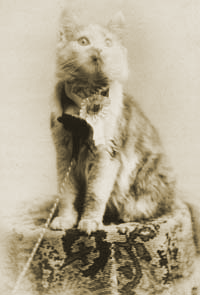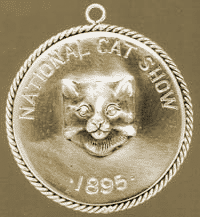 BREED HISTORY
BREED HISTORY

 ne of the oldest natural breeds in North America, the Maine Coon is
generally regarded as a native of the state of Maine (in fact, the Maine
Coon is the official Maine State Cat). There are a lot of legends connected
with Maine Coon origin.
ne of the oldest natural breeds in North America, the Maine Coon is
generally regarded as a native of the state of Maine (in fact, the Maine
Coon is the official Maine State Cat). There are a lot of legends connected
with Maine Coon origin.
Many people once believed the Maine Coon originated by interbreeding
the American bobcat with the domestic cats brought to North America
on the various sailing ships that came to the Northeastern seaboard.
Probably the tufted ears and feet of the Maine Coon, which are similar
to the bobcat's, gave some credence to this legend. The tuft curls
outward from the inside of the ears and tufts of fur are found between
the toes.
Taking fantasy one step farther is the belief that the domestic cats
of New England bred with raccoons. The early Maine Coons may simply have
looked like raccoons to the natives, since the brown tabby, with it's
bushy ringed tail, occurs most commonly in nature. The Maine Coon also
converses occasionally with an endearing trill or chirp, somewhat like
the cry of a young raccoon. It is genetically impossible for domestic
cats to breed with either raccoons or bobcats, as we in the cat fancy know,
because they are of different genera and do not hybridize.
Interestingly, the breeds closest to the Maine Coon are the Norwegian
Forest cat and Siberian cat which, although geographically distant,
evolved in much the same climate, and lends credence to the theory
that some of the cats responsible for developing the Maine Coon were
brought over by the Vikings.
More romantic versions of the Maine Coon's development have been handed
down over the years. The first involves Captain Samuel Clough and Marie
Antoinette. Captain Clough was one of the principals (or so the legend
goes) in a plot designed to smuggle the French queen out of France
and bring her to Wiscasset, Maine. The scheme was cut short, but not
before Clough had loaded his ship, the Sally, with luxurious furnishings,
priceless bric-a-brac, some of the queen's personal belongings, and
six of her favorite pet cats. While Clough waited, there was a sudden
outburst of violence. Marie Antoinette was seized, and eventually
beheaded. Captain Clough had to make sail with all haste to escape
repercussions for his part in the attempted rescue and with him went
the queen's possessions and the six longhaired cats still in his care.
It is assumed that the queen's cats bred with the American cats and
voila - the origin of the Maine Coon.
Still another legend concerns an English sea captain, improbably named Coon,
who was excessively fond of cats. He sailed up and down the New England
coast with his army of cats. Predominant in the group were his longhairs -
the Persians and Angoras that were popular in England. When the captain
went ashore, so did his cats. When longhaired kittens began appearing in
local litters, the owner's comment would be "one of Coon's cats."
A more logical conclusion is that the Maine Coon developed from the
domestic shorthaired cats of settlers who came to America with all
their worldly goods and the family pet. Later, as the country became
more civilized and the trading ships returned from their travels, the
sailors returned with longhaired cats. The new longhaired cats in turn
bred with the local shorthaired cats and began populating the Eastern
seaboard, and thus began the survival of the fittest. Those cats that
survived the harsh New England winters produced the next generation
of kittens. After nature finished combining the genetic ingredients
of form, coat, and substance of the Maine Coon Cat, man looked upon
these cats and said, "that is some pretty good cat." It was to be
expected that these intelligent cats would find their way into the
settlers' homes and become beloved pets as well as good workers
(mousers). It was during the 1860s that farmers would tell stories
and brag about the powers and intelligence of their Maine Coons.
During this decade these same farmers began having their own cat show
at the Skowhegan Fair where Maine Coons from all over the territory
competed for the title "Maine State Champion Coon Cat."
The most famous and largest of the early cat shows was held at New York's
Madison Square Garden in May of 1895. That show was won by a brown tabby
female Maine Cat named Cosey owned by Mrs. E. N. Barker.

The number of Maine Coon Cats entered in the show is not easily ascertained
since they were classified along with Persians and Angoras as "longhairs."
All cats were categorized first by hair length and then by sex. Cosey was
awarded a silver medal marked "National Cat Show, 1895".


The New York show did not develop into the prestigious event hoped for,
but the Boston show circuit did. Brown tabby Maine Coon Cats, King Max,
dominated this classic for three years, winning in 1897, 1898, and 1899,
until defeated by his son Donald in 1900.
Soon after this the Maine Coon Cat decreased in popularity as other
longhaired cats with pedigrees came into greater favor. Slowly, the
Maine Coon began disappearing from the ranks of the registry and shows.
The Maine Coon had its last big recorded victory for over 40 years
when a "longhaired blue Maine Cat" took first place in his class
and best of show, out of an entry of 170 cats, at the Portland,
Oregon show in 1911.
After that, Maine Coons slipped into the background and were shown
occasionally under the AOV category. Remaining in the background
during the next four decades, the Maine Coon Cat was declared extinct
in the late 1950s. In the early 1950s the Central Maine Cat Club
(CMCC) was formes as an effort to end the Maine Coon's slide into
a regional oddity and to give impetus toward record keeping and
showcasing for the breed. This club created one of the first written
standards for the breed, keeping records in the breeding of the
Maine Coon, and making people aware that the Maine Coons existed
and had credentials. People in other parts of the country were starting
to breed and show Maine Coons as well as keeping them as pets. They
were still being shown as AOVs, but they were beginning to appear
in the show halls from which they had disappeared.
During the first part of the 1970s the Maine Coon breeders requested
and were denied provisional status. In 1969-70 the first attempt was
made to bring the Maine Coon to provisional status. At the time, only
20 Maine Coons were registered. At the Spring 1974 it was announced
that CFA now had a Maine Coon Cat breed club. The members stated that
they had now fulfilled all the requirements for recognition of the
Maine Coon Cat as a provisional breed: they had a standard, a breed
club and 133 cats registered. The Maine Coon Cat was accepted for
provisional status beginning May 1, 1975 at the October 1974 board meeting.
Championship status occurred May 1, 1976. America's native longhair was
back on the show bench with championship status. Since 1976, the Maine
Coon Cat has been a rising star in the competitive reaches of the cat
fancy. The Maine Coon is the second most popular cat in CFA as seen
by the numbers of kittens registered.

|
 BREED HISTORY
BREED HISTORY





 ne of the oldest natural breeds in North America, the Maine Coon is
generally regarded as a native of the state of Maine (in fact, the Maine
Coon is the official Maine State Cat). There are a lot of legends connected
with Maine Coon origin.
ne of the oldest natural breeds in North America, the Maine Coon is
generally regarded as a native of the state of Maine (in fact, the Maine
Coon is the official Maine State Cat). There are a lot of legends connected
with Maine Coon origin.